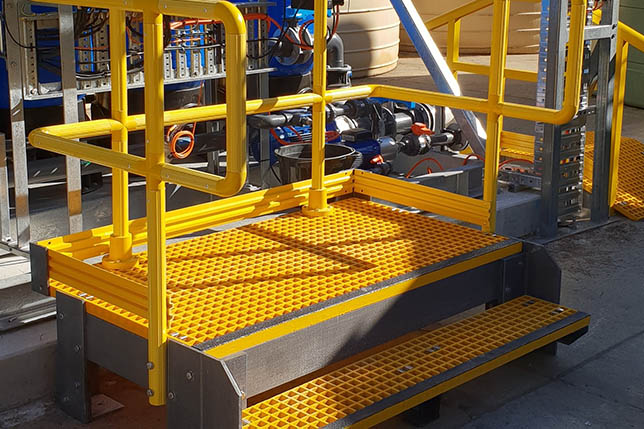
Introduction
FRP (Fiber Reinforced Polymer) platforms have emerged as revolutionary solutions across various industries. Their exceptional properties offer numerous advantages, making them a preferred choice for diverse applications.
Understanding FRP Platforms
What is FRP?
FRP refers to Fiber Reinforced Polymer, a composite material comprised of a polymer matrix reinforced with fibers. These platforms are engineered for structural integrity and resilience.
How FRP Platforms Operate FRP platforms utilize a combination of fibers such as glass, carbon, or aramid embedded within a polymer matrix. This synergy results in enhanced strength and durability, catering to specific application requirements.
Advantages of FRP Platforms
Increased Durability FRP platforms boast remarkable durability, outperforming traditional materials like wood or steel in harsh environments. Their resistance to corrosion and weathering ensures longevity.
Cost-effectiveness Despite initial investment, FRP platforms prove cost-effective in the long run due to minimal maintenance requirements and extended lifespan, reducing lifecycle costs significantly.
Versatility FRP platforms offer versatility in design and customization, adapting to complex project specifications effortlessly. Their inherent flexibility allows for seamless integration into diverse applications.
Corrosion Resistance One of the key advantages of FRP platforms is their exceptional resistance to corrosion, making them ideal for environments prone to chemical exposure or moisture.
Easy Installation Compared to traditional materials, FRP platforms feature lightweight construction, facilitating swift and hassle-free installation. This not only saves time but also minimizes labor costs.
Eco-friendliness FRP platforms align with sustainability goals as they are manufactured using recyclable materials and consume less energy during production. Their eco-friendly nature contributes to environmental preservation.
Low Maintenance With minimal maintenance requirements, FRP platforms offer operational convenience and cost savings over their lifecycle. Routine inspections and cleaning suffice to maintain their performance.
Design Flexibility FRP platforms provide architects and engineers with unparalleled design freedom, enabling the realization of intricate structures and innovative concepts without compromising structural integrity.
Safety The non-conductive nature of FRP platforms enhances safety in electrical and high-voltage environments, reducing the risk of accidents and ensuring worker protection.
Longevity FRP platforms exhibit exceptional durability, withstanding wear and tear over extended periods, thereby offering reliable performance throughout their service life.
Real-world Applications
FRP platforms find extensive use across diverse industries, including:
- Construction Industry: Utilized in walkways, bridges, and access platforms due to their lightweight nature and corrosion resistance.
- Automotive Sector: Employed in vehicle components and body panels for enhanced durability and fuel efficiency.
- Aerospace Industry: Utilized in aircraft interiors and structural components due to their high strength-to-weight ratio and fire resistance.
Comparison with Traditional Materials
Strength and Weight Ratio Compared to traditional materials like steel, FRP platforms offer a superior strength-to-weight ratio, enabling the construction of lighter yet robust structures.
Maintenance Requirements Unlike steel or wood, FRP platforms require minimal maintenance, reducing downtime and operational costs associated with repairs and replacements.
Environmental Impact FRP platforms contribute to environmental sustainability through reduced resource consumption and energy expenditure during manufacturing and usage phases, unlike steel or concrete.
Overcoming Challenges
Initial Cost Although initial investment in FRP platforms may seem higher than conventional materials, their long-term benefits in terms of durability and low maintenance outweigh the initial expenditure.
Design Limitations While FRP platforms offer significant design flexibility, certain complex structures may pose challenges due to material constraints or manufacturing limitations. However, ongoing advancements in technology are gradually addressing these limitations.
Frequently Asked Questions (FAQs)
What are FRP platforms?
FRP platforms are structural elements made from a composite material comprising a polymer matrix reinforced with fibers.
How long do FRP platforms last?
FRP platforms have a long service life, often lasting several decades, thanks to their inherent durability and resistance to corrosion.
Are FRP platforms suitable for outdoor use?
Yes, FRP platforms are ideal for outdoor applications due to their weather resistance and UV stability, ensuring performance in various climatic conditions.
Can FRP platforms support heavy loads?
Despite being lightweight, FRP platforms possess high strength characteristics, enabling them to support heavy loads with ease.
Are FRP platforms recyclable?
Yes, FRP platforms are recyclable, contributing to environmental sustainability by reducing waste and resource consumption.
What is the maintenance required for FRP platforms?
Maintenance for FRP platforms primarily involves routine inspections for damage or wear and occasional cleaning to preserve their appearance and performance.
Conclusion
In conclusion, the advantages of using FRP platforms are vast and diverse, ranging from durability and cost-effectiveness to sustainability and safety. As industries continue to prioritize efficiency and environmental stewardship, FRP platforms emerge as indispensable solutions offering unmatched performance and reliability. With ongoing advancements in materials science and manufacturing processes, the future of FRP platforms remains promising, shaping the landscape of modern infrastructure and innovation.
Read More Blogs:
How Do Industrial Working Platforms Increase Efficiency and Productivity?
Are Industrial Working Platforms Suitable for Different Industries? A Comprehensive Guide [2024]
What Safety Features Should I Consider for Industrial Working Platforms?
Which Types of Industrial Working Platforms are Best for Specific Tasks?
Leave a comment